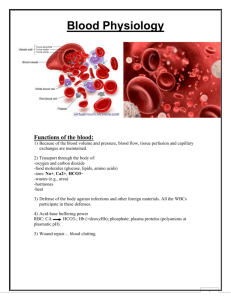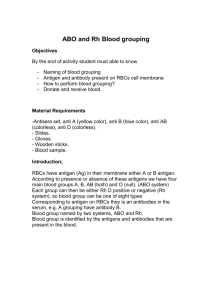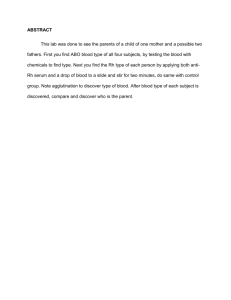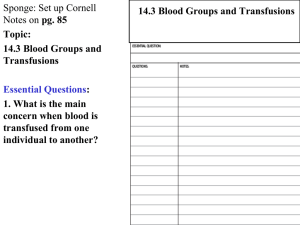P2 Blood grouping and cross match
advertisement
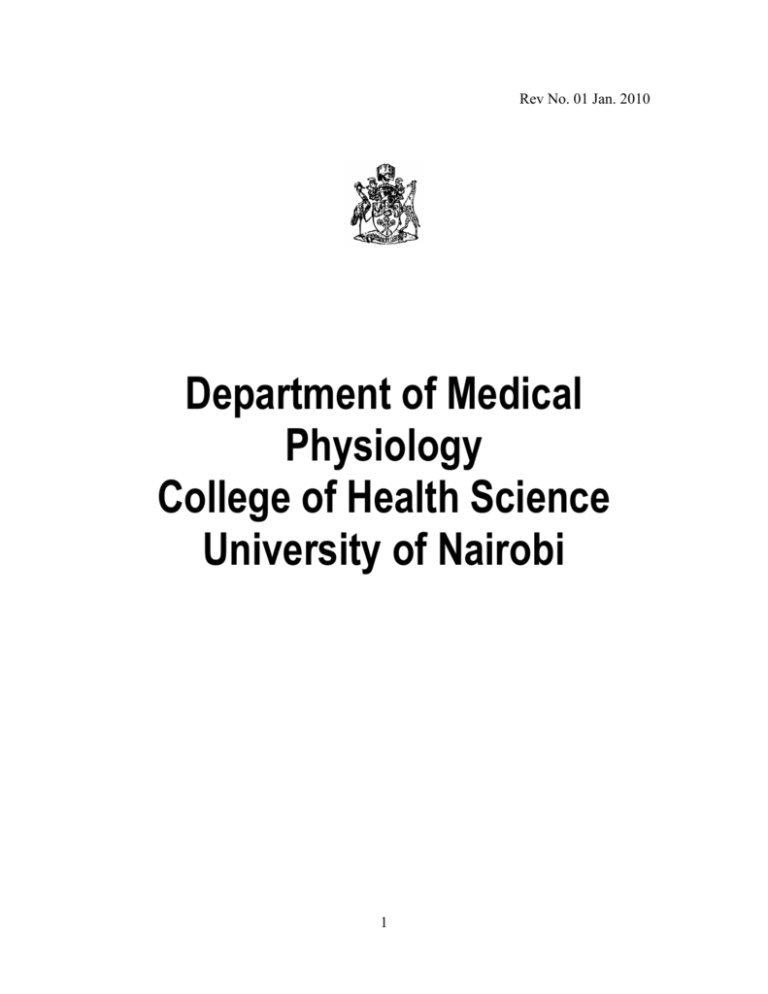
Rev No. 01 Jan. 2010 Department of Medical Physiology College of Health Science University of Nairobi 1 PRACTICAL 2 BLOOD GROUPING AND CROSS-MATCHING The introduction of a substance of large molecular size (an antigen) into the body leads to the production in the body of a substance called an antibody which can interact specifically with the antigen in different ways. This basic physiological mechanism of antigen-antibody reaction has the effect of ultimately removing or inactivating the antigenic substance and forms one of the important mechanisms of immunity. Antibodies are a class of proteins called globulins and are now referred to as immunoglobulins. They are produced by B-lymphocytes through their transformation into plasma cells on exposure to the antigen substance. There are several classes of immunoglobulins (IgG, IgM, IgA, IgD, IgE) and they are present in the plasma as well as at certain other sites such as secretions from mucous membranes, cells surfaces etc. A second exposure to the same antigen leads to a quicker and greater production of antibody than on the first occasion. The transfusion of blood from one person to another for therapeutic purposes can lead to reactions of the antigen-antibody type unless care is exercised. Human blood can be classified into several different groups depending on the presence of different antigenic substances on the red blood cell. One such group, the ABO system, depends on the presence of polysaccharide substances designated A,B and O in REC cell membrane. In the presence of appropriate antibody to these substances designated nti-a and anti-b, the red cells can be agglutinated or clumped together and haemolysed. The antigenic substances A,B and O are therefore referred to as agglunogens and the antibodies are called agglutinins. The antibody acting against antigen (agglutinogen) A, is called agglutinin alpha or anti-a. Similarly the antibody acting against antigen (agglutinogen) B, is called agglutinin beta or anti-b. Group specific substance O does not normally act as an antigen and there is no corresponding agglutinin. Through very rarely by repeated transfuse on anti-O can be produced in some individuals. Landsteiner in 1909 showed that:a) If an agglutininogen (antigen) of the ABO system is present on the red cells of a person the corresponding agglutinin (antibody) is absent from the plasma of the person. (this is a logical outcome as otherwise the cells of the person would be agglutinated) b) If the agglutinogen is absent from the red cells the corresponding agglutinini (antibody) is present in the plasma of the person. (This is not necessary consequence to the normal antibody production mechanism as an antibody is usually produced only on exposure to an antigen; but as far as the ABO group 2 system is concerned this holds true). The Landsteiner’s law, as the foregoing is sometimes called, leads to the situation shown in the following table. Blood Group of Person A B AB O Antigen on RBC A B A&B O (non-antigenic) Antibody I Plasma Anti-b Anti-a …….. Anti-a and Anti-b Antigen A is composed of two subclasses called A1 and A2 with corresponding anti-a1 and anti-a2 agglutinins. The concentration of anti-a and anti-b in the plasma varies from individual to individual. There is another important group in man called the Rhesus or Rh group. The Rhesus antigen is so called because it is also present on the arb of the Rhesus monkey. A high proportion of humans have the Rh antigen and are therefore called Rh+ve those who do not have the antigen are Rh-ve. The Rh antigen is compound antigen composed of several different substances designated DCE etc. Unlike in ABO system those without the Rh antigen (Rh0-ve) the RBC do not naturally carry antigen-Rh substance in the plasma (Vide Landsteiner’s Law). Such an individual on receiving Rh+blood begins to produce anti-Rh as part of normal antigen-antibody reaction. EXPERIMENT 1 TESTING BLOOD GROUP Prick the tip of your finger with sterile haemolet provided and add two drops of blood to about 1 ml of isotonic saline in a small test tube to provide a suspension of your red blood cells. Use this suspension for the following experiments. You are provided with serum containing anti-a (a1 and a2) and anti-b 1. Place two separate drops of the saline suspension of your red cells on a glass slide. 2. Add one drop of anti-a serum to one drop and of anti-b serum to the other. 3. Clearly mark the pipettes and test-tubes with the markers provided to avoid mixup. Do not contaminate the pipettes used to deliver the serum. 4. Mix by gently rocking the slide for 5 mins. 5. Examine macroscopically against a white background. 6. Place a cover slip and examine under the microscope. You should be able to recognize fine degrees of agglutination. If your slide does not show agglutination see that you examine one that shows it. 3 7. Observe whether agglutinated masses of red cells can be broken up easily. Exercises 1. How do the relative frequencies of the various groups in your class compare with the figures quoted in the textbook? 2. What is the difference between agglutination, rouleaux formation and clotting? 3. What group it termed the universal donor and universal recipient? Do you agree with this concept? EXPERIMENT 2 RHESUS FACTOR 1. Mix a drop of your red cells in saline suspension with a drop of 20% bovine albumin on a glass slide. 2. Observe whether agglutination occurs. 3. Now add a drop of anti-Rh (ant-D) serum to the bovine albumin and red cells and observe whether agglutination occurs? The bovine albumin is used because the Rh antibody is more effective in producing agglutination in vitro the presence of bovine albumin. Exercise 1. Compare the proportions of Rh+ and Rh- subjects in your class with those quoted in the textbook. 2. Discuss the possible effects of a) Transfusing a Rh- woman with Rh+ blood, b) A Rh- woman conceiving a Rh+ foetus, and c) Transfusing a Rh- male with Rh+ blood EXPERIMENT 3 CROSS-MATCHING Since there are other groups than the ABO and Rh groups the only sure way of determining whether the blood of an individual can be transfused into another (compatible) is by testing the bloods for agglutination against each other. In transfusion practice the grouping of the donor and recipient is always followed by this procedure except in extreme emergencies. You are provided with a sample of human serum to determine whether this person can receive your blood in a transfusion. 4 1. Set up a drop of your red cell suspension with a drop of the serum. 2. Set up another mixture which contains a drop of bovine albumin in addition. Can you explain why this is done? 3. Examine both for agglutination after mixing. Questions to consider 1. Should the cells of the individual be tested against your serum before a transfusion of your blood can be considered safe? Give reasons for the answer. 2. Why is the donor and recipient grouped before the cross-matching procedure? 3. In an extreme emergency if there is no time for cross-matching of blood, what blood group would be the safest to use? EXPERIMENT 4 ROULEAUX FORMATION One of the factors on which the Erthrocyte sedimentation rate (ESR) depends on is the tendency to Rouleaux formation. The red cells adhere to one another by their flat surfaces forming an arrangement which resembles a stack of coins which has been toppled. 1. Put a drop of oxalated human blood on a slide and mount a coverslip. 2. Examine with the naked eye and then under the low power of the microscope. Describe what you see. EXPERIMENT 5 CLOTTING TIME (the capillary method) 1. Prick your finger and obtain a large drop of blood. 2. Hold a length of plain non-heparnized capillary tube to the drop and allow it to fill by capillarity. 3. Note the time when the tube is full. 4. Every minute thereafter make a scratch near the end of the tube and cut off a small piece. When clotting occurs, fibrin threads will be seen to connect the two pieces. 5. Note that time again and record the clotting time in the results sheet for your class. EXPERIMENT 6 HAEMOLYSIS AND FRAGILITY OF RED BLOOD CELLS Introduction 5 The red blood cell contains a fixed amount of solute within its membrane. The membrane of the cell has special permeable properties which enables it to swell or shrink depending on whether the surrounding solution is Hypotonic or hypertonic. In solutions, the cell will swell and in hypotonic ones it will shrink. At a critical volume of the cell the tension on the membrane will cause it to rapture and thereby release its contents into the surrounding solution. This process is called haemolysis. In these experiments you will examine the behavior of red cells towards one solute of different concentrations. 1. Put a measured volume of blood in a series of tubes. 2. Centrifuge each tube to remove undamaged cells. 3. The amount of haemolysis which has taken place will be estimated by measuring the amount of haemoglobin that is free in the supernatant solution. 4. This is estimated from the amount of green light that is absorbed by certain thickness of the solution in a spectrophotometer (optical density). How a Spectrophotometer Works Light from a lamp is passed through a monochromatic filter of complementary colour (in this case green = 540mm) to the solution under test and then through a standard thickness of solution. The emergent light falls on a photoelectric cell which is connected to a micrometer having an inverse logarithmic scale. The cell produces current in direct proportion to the amount of light reaching its surface. The optical density of a substance is, by definition, equal to the:Amount of incident light Amount of transmitted light Hence the scale on the meter will indicate the optical density of the solution. Procedure The solute to be tested is Sodium chloride 1. Prepare eight tubes by diluting 0.125 molar NaCI solution in the proportions shown and mix well. Tube 1 2 3 4 5 6 7 NaCI 8.0 7.0 6.4 5.8 5.2 4.6 4.0 Water (cc) 2.0 3.0 3.6 4.2 4.8 5.4 6.0 Concentration (%) 0.58 0.51 0.47 0.42 0.38 0.34 0.29 6 8 0 10.0 0 2. To each tube add 50 cu.mm (0.05 ml) of blood and mix thoroughly. Sedimentation occurs rapidly if proper mixing is not done and this will cause errors. 3. Centrifuge the set of tubes at high speed for 10 min. 4. Decant the supernatant solution from each tube, which should be perfectly clear, into a special spectrophotometer tube 5. Measure the reading of tube 8 which will give the value for complete haemolysis. 6. The haemolysis for the remaining tubes is given by simple proportion e.g. if tube 8 gives a reading of 4 units, then a tube reading 1.0 units shows. 1.0/40 x 100 = 25% haemolysis You will plot the percentage haemolysis as the ordinate against osmolar concentration of the solute as the abscissa in your laboratory report. 1. In a tube place 10ml. 0.125 molar NaCI solution and add 50 cu.mm of blood. 2. Now add 1 drop of teepol. Haemolysis occurs because teepol, a synthentic detergent, is surface active and disperses the cell membrane. Your experiments with NaCI will have indicated that there is a range of concentration over which haemolysis occurs and therefore a range of ‘toughness’ of red cell membrane. In clinical use. The first dilution of NaCI solution in which haemolysis begins to be observable is sometimes taken as measure of ‘fragility’ although the full test is usually performed in clinical practices. Questions to consider 1. What is the fragility of the sample of blood? 2. Is the nature of teepol haemolysis likely to be due to its surface active properties? Give your reasons. 3. If the volume of a given red cell were constant, what would be the effect on fragility if the rbc started off as:a. Flatter than the normal biconcave disc? b. More spherical than normal? 4. Can you name several disease conditions in which cell fragility is altered? 5. How many grams of Na2 SO4 would be required to make one litre of solution isosmotic with blood (0.3 osmolar)? Atomic weights: Na = 23, S=32, 0=16 6. What is the difference between the terms isosmotic and isotomic? 7 Haematological Techniques Laboratory Report Date of practical _______________________ Group __________________ Student Reg. No. _______________________ Practical Group Blood Type A B AB Rhesus Factor O Rh+ Rh- Clotting time (mins) Rouleaux formation Presence (+) Absent (-) A B C D E F Total % distribution Practical Group Bench A B C D E F Average SD Haemolysis Tube 1 Tube 2 Tube 3 Tube 4 Tube 5 Tube 6 Tube 7 Tube 8 Plot the graph of haemolysis showing the mean and SD. Laboratory reports are due within 7 DAYS after the practical. Lateness will be penalized by loss of marks. 8


